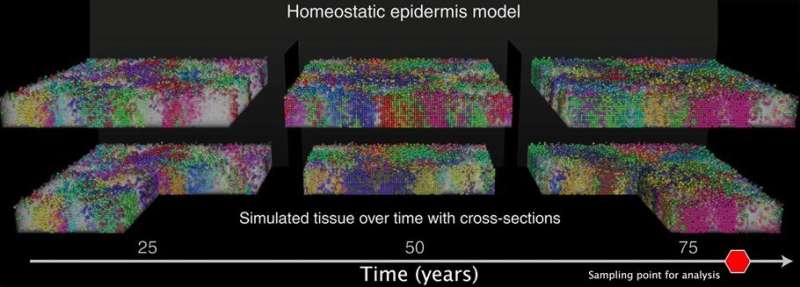Researchers use computer modeling to understand how self-renewal processes impact skin cell evolution

All normal human tissues acquire mutations over time. Some of these mutations may be driver mutations that promote the development of cancer through increased proliferation and survival, while other mutations may be neutral passenger mutations that have no impact on cancer development. Currently, it is unclear how the normal self-renewal process of the skin called homeostasis impacts the development and evolution of gene mutations in cells. In a new study published in the Proceedings of the National Academy of Sciences (PNAS), Moffitt Cancer Center used mathematical and computer modeling to demonstrate the impact of skin homeostasis on driver and passenger mutations.
Skin cells undergo a normal life and death cycle of homeostasis. Cells in the lower basal layer proliferate, grow and move into the upper layers of the skin while undergoing cell differentiation and maturation. Eventually, the skin cells migrate into the uppermost layer of the skin where they form a protective barrier, die and are sloughed off.
Homeostasis is typically maintained in the skin. Its thickness and growth do not significantly change over time, despite the accumulation of mutations. This is different from other tissue types that undergo increased growth and proliferation due to mutations. However, scientists are not sure how cell mutations in the skin evolve and form subclones, or groups of cells derived from a single parent cell, without impacting normal skin homeostasis.
Moffitt researchers developed a computer simulation model to address these uncertainties and improve their understanding of the impact of skin homeostasis on gene mutations and subclone evolution. Computer modeling can address complex biological relationships among cells that cannot be studied in typical laboratory settings.
The researchers built their model based on the normal structure of the skin, including a constant cell number based on self-renewal, a constant tissue height and a constant number of immature stem cells. They incorporated patient mutation data using GATTACA, a tool allowing you to introduce and track mutations, into their model to assess how mutations and UV exposure impact skin homeostasis and clonal populations. They also investigated the impact of two genes that are commonly mutated in nonmelanoma skin cancer, NOTCH1 and TP53.
"This study prompted the creation of several new tools, such as GATTACA, which allows you to induce and track base pair resolution mutations in any agent-based modeling framework with temporal, spatial and genomic positional information," said the study's lead author Ryan Schenck, Ph.D., a mathematical oncology programmer in Moffitt's Department of Integrated Mathematical Oncology. "Along with my lab colleague Dr. Chandler Gatenbee, we also developed EvoFreq to help visualize evolutionary dynamics, now being used in many of our publications."
The researchers demonstrated that both passenger and driver mutations exist in subclones within the skin with a similar size and frequency. Most mutations that occur in immature stem cells are lost or are present in smaller subclones due to random stem cell death and replacement, while larger subclones are likely due to persistence and older age. Large NOTCH1 and TP53 subclones are rarely observed because they would destroy the homeostasis of the skin; however, those large subclones that do exist likely arose during an early age.
The researchers used their model to determine when subclones with NOTCH1 and TP53 mutations have a selective fitness advantage over neighboring cells without mutations. They showed using their model that subclones with NOTCH1 mutations may prevent neighboring cells from dividing into their positions, while subclones with TP53 mutations may be resistant to cell death from UV exposure. The researchers hope that their model can be used to study other processes impacted by homeostasis that cannot be studied with typical laboratory approaches.
"This work broadens our current understanding of selection and fitness acting in a homeostatic, normal tissue, where subclone size more reflects persistence rather than selective sweeps, with larger subclones being predominately older subclones," said Alexander Anderson, Ph.D., chair of Moffitt's Department of Integrated Mathematical Oncology. "This model strives to provide a means to explore mechanisms of increased fitness in normal, homeostatic tissue and provides a simple framework for future researchers to model their hypothesized mechanisms within squamous tissue."
More information: Ryan O. Schenck et al, Homeostasis limits keratinocyte evolution, Proceedings of the National Academy of Sciences (2022). DOI: 10.1073/pnas.2006487119

















